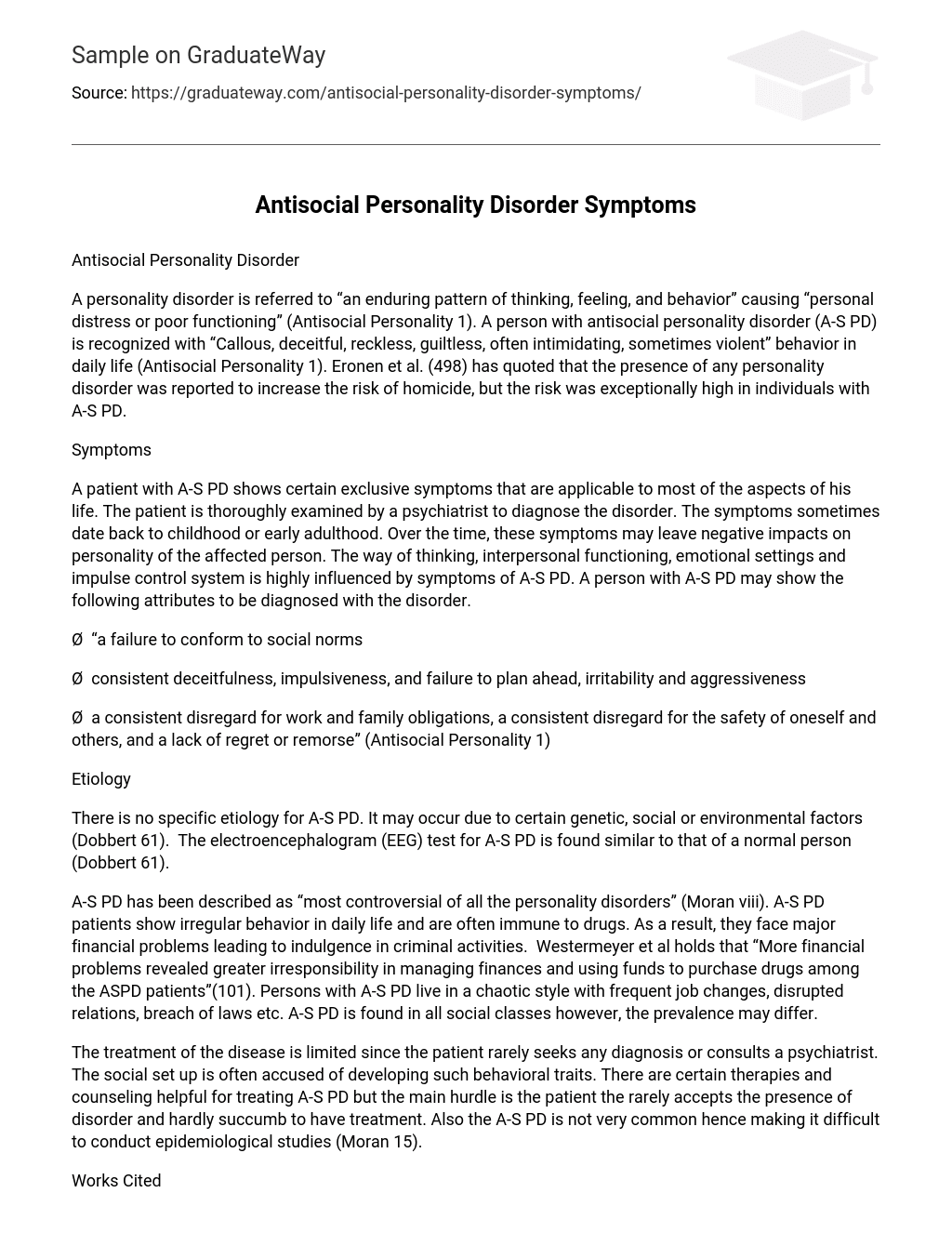Antisocial Personality Disorder
A personality disorder is referred to “an enduring pattern of thinking, feeling, and behavior” causing “personal distress or poor functioning” (Antisocial Personality 1). A person with antisocial personality disorder (A-S PD) is recognized with “Callous, deceitful, reckless, guiltless, often intimidating, sometimes violent” behavior in daily life (Antisocial Personality 1). Eronen et al. (498) has quoted that the presence of any personality disorder was reported to increase the risk of homicide, but the risk was exceptionally high in individuals with A-S PD.
Symptoms
A patient with A-S PD shows certain exclusive symptoms that are applicable to most of the aspects of his life. The patient is thoroughly examined by a psychiatrist to diagnose the disorder. The symptoms sometimes date back to childhood or early adulthood. Over the time, these symptoms may leave negative impacts on personality of the affected person. The way of thinking, interpersonal functioning, emotional settings and impulse control system is highly influenced by symptoms of A-S PD. A person with A-S PD may show the following attributes to be diagnosed with the disorder.
- a failure to conform to social norms
- consistent deceitfulness, impulsiveness, and failure to plan ahead, irritability and aggressiveness
- a consistent disregard for work and family obligations, a consistent disregard for the safety of oneself and others, and a lack of regret or remorse” (Antisocial Personality 1)
Etiology
There is no specific etiology for A-S PD. It may occur due to certain genetic, social or environmental factors (Dobbert 61). The electroencephalogram (EEG) test for A-S PD is found similar to that of a normal person (Dobbert 61).
A-S PD has been described as “most controversial of all the personality disorders” (Moran viii). A-S PD patients show irregular behavior in daily life and are often immune to drugs. As a result, they face major financial problems leading to indulgence in criminal activities. Westermeyer et al holds that “More financial problems revealed greater irresponsibility in managing finances and using funds to purchase drugs among the ASPD patients”(101). Persons with A-S PD live in a chaotic style with frequent job changes, disrupted relations, breach of laws etc. A-S PD is found in all social classes however, the prevalence may differ.
The treatment of the disease is limited since the patient rarely seeks any diagnosis or consults a psychiatrist. The social set up is often accused of developing such behavioral traits. There are certain therapies and counseling helpful for treating A-S PD but the main hurdle is the patient the rarely accepts the presence of disorder and hardly succumb to have treatment. Also the A-S PD is not very common hence making it difficult to conduct epidemiological studies (Moran 15).
Works Cited
- Antisocial Personality – Part I. Harvard Mental Health Letter, 10575022, Dec2000, Vol. 17, Issue 6
- Dobbert, Duane L. Understanding Personality Disorders: An Introduction. Greenwood Publishing Group, 2007
- Eronen M., Hakola P. & Tiihonen J. (1996). Mental disorders and homicidal behavior in Finland. Arc Gen Psychiatry, 53, 497-501.
- Moran, Paul. Antisocial Personality Disorder: An Epidemiological Perspective. RCPsych Publications, 1999
- Westermeyer, Joseph; Thuras, Paul. Association of Antisocial Personality Disorder and Substance Disorder Morbidity in a Clinical Sample. American Journal of Drug & Alcohol Abuse, Feb 2005, Vol. 31 Issue 1, p93-110, 18p, 2 charts; DOI: 10.1081/ADA-2000





